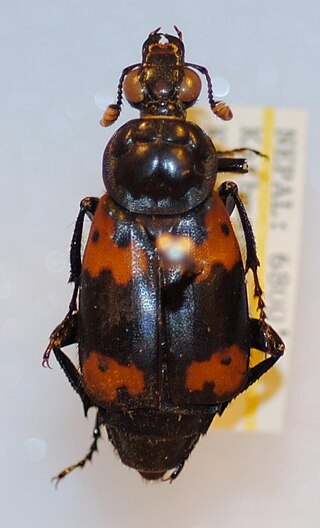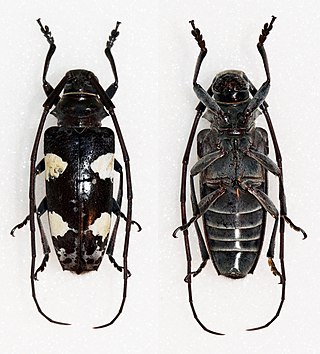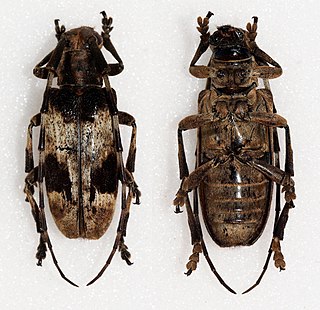
Alnus nepalensis is a large alder tree found in the subtropical highlands of the Himalayas. The tree is called Utis in Nepali and Nepalese alder in English. It is used in land reclamation, as firewood and for making charcoal.

Wildlife diversity is a notable feature of Nepal. Because of the variance in climate, from tropical to arctic, Nepal has a large variety of plants and animals. Wildlife tourism is a major source of tourism in the country. There are some animal species which are unique to Nepal, such as the spiny babbler. Nepal is also host to many rhododendron species. Nepal has numerous national parks and reserves to protect its diverse fauna. Nepal is a biodiversity hot spot with ecoregions broadly comprising the mountainous ecoregion, the savanna and grasslands ecoregion of the terai (foothills), and the Rara Lake ecoregion.

Nicrophorus nepalensis, commonly known as a burying beetle, is widespread across tropical and subtropical countries in Asia. It belongs to the order Coleoptera and the family Silphidae, and is part of the nepalensis species-group, which is the second largest species group within the genus Nicrophorus. N. nepalensis differs from some other beetles in that it exhibits biparental care. Its role as a decomposer is crucial in the energy cycle and energy transformation in the ecosystem.

Hedera nepalensis is a species of perennial Ivy native to Nepal and Bhutan, as well as Afghanistan, Pakistan, India, China, Laos, Myanmar, Thailand, and Vietnam, at altitudes of about 1000–3000 m. Plants grow up to 30 m in height, with simple leaves ranging from 2–15 cm long, and yellow flowers.

Coriaria nepalensis is a shrub of the genus Coriaria. It grows in the foothills of the Himalayas. It blooms in spring and has bright yellow flowers and red fruits in summer.

Blepephaeus is a genus of longhorn beetles of the subfamily Lamiinae, containing the following species:
Blepephaeus andamanicus is a species of beetle in the family Cerambycidae. It was described by Stephan von Breuning in 1935. It is known from the Andaman Islands.
Blepephaeus indicus is a species of beetle in the family Cerambycidae. It was described by Stephan von Breuning in 1935. It is known from India.
Blepephaeus lemoulti is a species of beetle in the family Cerambycidae. It was described by Stephan von Breuning in 1938. It is known from Laos.
Blepephaeus strandi is a species of beetle in the family Cerambycidae. It was described by Stephan von Breuning in 1936.
Blepephaeus fulvus is a species of beetle in the family Cerambycidae. It was described by Maurice Pic in 1933. It is known from Malaysia, China, Vietnam, and Thailand.
Blepephaeus higaononi is a species of beetle in the family Cerambycidae. It was described by Vives in 2009. It is known from the Philippines.

Blepephaeus irregularis is a species of beetle in the family Cerambycidae. It was described by Heller in 1915. It is known from the Philippines. It contains the varietas Blepephaeus irregularis var. alboreductus.
Blepephaeus puae is a species of beetle in the family Cerambycidae. It was described by Lin in 2011. It is known from China.
Blepephaeus stigmosus is a species of beetle in the family Cerambycidae. It was described by Charles Joseph Gahan in 1895. It is known from Malaysia, Laos, and Myanmar. It contains the varietas Blepephaeus stigmosus var. laosensis.
Blepephaeus subcruciatus is a species of beetle in the family Cerambycidae. It was described by White in 1858.

Blepephaeus succinctor is a species of beetle in the family Cerambycidae. It was described by Louis Alexandre Auguste Chevrolat in 1852, originally under the genus Monohammus. It is known from Malaysia, India, Sumatra, Myanmar, Taiwan, China, Thailand, and Vietnam. It feeds on Acacia confusa, Albizia chinensis, Firmiana simplex, Melia azedarach, Morus alba, and Vernicia fordii.
Blepephaeus undulatus is a species of beetle in the family Cerambycidae. It was described by Maurice Pic in 1930.







